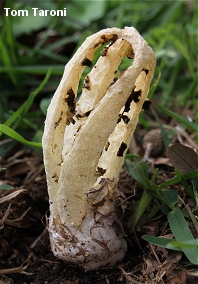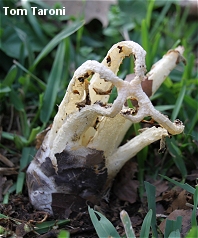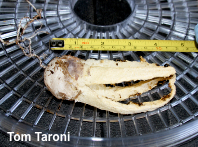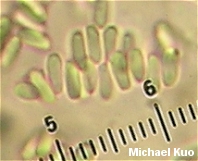| Major Groups > Stinkhorns > Blumenavia rhacodes |

|
Blumenavia rhacodes [ Agaricomycetes > Phallales > Clathraceae > Blumenavia . . . ] by Michael Kuo Originally described from Brazil, this interesting stinkhorn began to be documented in the Houston, Texas area in the early nineties; it may have been introduced through Houston shipping from South America. On casual inspection it looks like a white version of Clathrus columnatus, but its spore slime is produced on conspicuous membranous "glebifers" that are attached to the inner surfaces of the arms. There are, believe it or not, several similar-looking mushrooms—but none of them is typically as quite as large as Blumenavia rhacodes. Tanzania's Blumenavia usambarensis has white arms with glebifers only on the upper half of each arm, and smaller spores; Mexico's Blumenavia heroica and Blumenavia toribiotalpaensis feature grooved arms—the former with arms of even width and the latter with arms that narrow to the apex. Brazil's Blumenavia baturitensis has funky, finger-like glebifers and arms that narrow to the apex, while Blumenavia crucis-hellenicae, also from Brazil, has delicate, thin arms and a cross-shaped glebifer suspended from the apex of the structure. And now we arrive at "Blumenavia angolensis," which is a name frequently encountered in field guides and stinkhorn literature. Despite widespread use of its name, the species itself is poorly understood and has not been adequately defined in a contemporary treatment (see the linked page if you feel this statement needs justification). If Blumenavia angolensis is a useable name, it refers to a small and graceful, pure white species from Angola with glebifers only near the top and an odor of fermented grapes; its distribution is uncertain. Thanks to Tom Taroni for collecting, documenting, and preserving Blumenavia rhacodes for study; his collection is deposited in The Herbarium of Michael Kuo. Description: Ecology: Saprobic; growing alone or gregariously--often near stumps or woody debris; originally described from Brazil; distributed, at a minimum, from Brazil through Mexico and into Texas, but precise distribution limits are uncertain due to confusion with other species. The illustrated and described collection is from Texas. Fruiting Body: When young appearing like a whitish to brown or black "egg," but soon "hatching" and developing into a cage-like structure measuring up to 13 cm high and 5 cm wide; oval in shape, composed of 3–5 unbranched, pale yellow to creamy whitish arms that are joined at the top; arms about 1–1.5 cm wide, in cross-section more or less triangular or four-sided, with the outer surface fairly flat (but lacking a pronounced longitudinal groove) and the inner surfaces more rough, punctuated by membranous flaps of tissue ("glebifers"); the edges between outer and inner surfaces often appearing jagged or "toothed"; spore slime dark brown, produced on the glebifers on the inner surfaces of the arms, from the top of each arm nearly to the bottom; bases of arms free, but encased in a whitish to dark gray, dark brown, or nearly black volva; base attached to prominent white rhizoids. Microscopic Features: Spores 3–4 x 1–1.5 µm; cylindric; smooth; hyaline in KOH; inamyloid. Hyphae of the volva 2–7 µm wide; smooth; hyaline in KOH; with clamp connections. REFERENCES: Möller, 1895. (Lloyd, 1905; Dring, 1980; López et al., 1981; Calonge et al., 2004; Vargas-Rodriguez & Vázquez-García, 2005; López & García, 2012; Trierveiler-Pereira et al., 2014; Melanda et al., 2020.) Herb. Kuo 02211201. This site contains no information about the edibility or toxicity of mushrooms. |
© MushroomExpert.Com |
|
Cite this page as: Kuo, M. (2022, May). Blumenavia rhacodes. Retrieved from the MushroomExpert.Com Web site: http://www.mushroomexpert.com/blumenavia_rhacodes.html |



